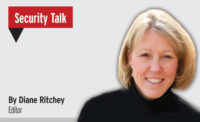
Travelers flying Scandinavian Airlines (SAS) use a biometric fingerprint check-in system to board airline flights.
Biometrics have been in the marketplace for more than two decades, protecting facilities that are vital to national security, preventing unauthorized people from crossing borders, and preserving the integrity of financial systems and data networks. For security executives at California State University, Chico, they are helping to track time and attendance reporting.
The Associated Students at California State University, Chico (AS) uses seven Schlage HandPunch time and attendance readers at employee entrances throughout the student union and dining facilities to track the attendance of approximately 1,200 student and career employees. Readers are used at the student union, student services on campus, dining and food services.
“Some of the employees had become very clever in the way that they had friends clock in and out for them,” said Matt Norby, IT director for the AS. “Some of these areas were high volume, which made it difficult for the manager to track such ‘buddy-punching.’ As a result, we decided to use hand geometry readers to track time and attendance reporting.”
For time/attendance/payroll use, AS employees use the keypad on the Hand-
Punch reader to enter their ID number and then place their hand in the hand reader. The reader simultaneously analyzes more than 31,000 points of the hand’s length, width, thickness and surface area to instantaneously record more than 90 separate measurements and verify users.
Traveling Smart
Biometrics is also helping Scandinavian Airlines (SAS), reportedly the first airline in the world to offer its passengers fingerprint check-in.
New European Initiatives require that airline companies can verify that a domestic passenger checking in baggage also boards the aircraft.
Here’s how it works: passengers check in at usual at SAS’ unattended self-service kiosks. The baggage is then handed in at the baggage drop, where the passenger registers his/her finger on a fingerprint reader, creating a link between the passenger and the baggage. At the gate, the passenger puts the same finger on a fingerprint reader before boarding. SAS can then verify that both the passenger and the baggage are on board the plane.
With the new system, said Helena Trannaeus Bonnedal of SAS, the airline has kept its short passenger waiting time and efficiency, and at the same time, still complies with the new EU resolution. “According to studies, 80 percent of passengers find the solution very efficient."
No Fingerprints, No Boarding
Non-U.S. citizens entering the United States, whether their visit is two days or two years, are most likely familiar with having their fingerprints taken. The Department of Homeland Security, through its US?VISIT program, began collecting biometrics—digital fingerprints and a photograph—in 2004, from non?U.S. citizens (ages 14-79) applying for Visas and arriving at U.S. ports of entry.Yet earlier this summer, travelers to the United States, if they flew out of Atlanta or Detroit, were required to be fingerprinted again, through the US-VIST program, as DHS launched tests at Hartsfield-Jackson Atlanta International Airport and Detroit Metropolitan Wayne County Airport. In Atlanta, Transportation Security Administration (TSA) officers collected biometrics from travelers at TSA checkpoints. In Detroit, U.S. Customs and Border Protection (CBP) officers collected biometrics from travelers at the boarding gate.
According to Anna Hinken, a DHS Spokesperson, DHS wanted a faster and more accurate way to determine whether non-U.S. citizens have departed or remained in the U.S. illegally, as approximately 13 million people per year stay past their Visa expiration date.
Hinken emphasized that the process is being tested, and not the technology. “Whether TSA or Border Protection does the testing, we are trying to find the best process” she said. She added that the process does not delay passenger boarding of an airplane or take-off and/or landing times because the fingerprint process begins one hour before boarding begins. Since May, approximately 23,596 people traveling through Atlanta and Detroit have gone through the new system, Hinken said. All of the biometrics information collected feeds into the same database that was set up in 2004.
The program has been so successful, Hinken said, that US?VISIT plans to begin implementing new biometric exit procedures for travelers via airports within the next year. Non?U.S. citizens traveling to the United States will be notified about the testing and any new requirements before they take effect.






